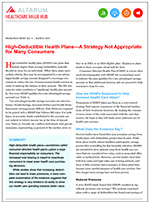Improving Value
High Deductible Health Plans Don't Work
Research suggests that high-deductible health plans (HDHPs) are inappropriate for many consumers, leading them to cut back on both necessary and unnecessary care, as well as leaving them with unmanageable amounts of medical debt. Given the numerous alternatives to address high healthcare costs and evidence around smarter cost-sharing design, it is curious why these plans continue to be so vigorously defended.
[Consumer Directed Health Plan (CDHP) is a term often used interchangeably with HDHP but is more often used to indicate the plan qualifies for a tax-advantaged savings account and/or that additional decision aids are present to help consumers shop for care.]
There is no debate that higher deductibles lower premiums. This occurs for two reasons: (1) because the design shifts costs away from the health plan and onto consumers but also (2) because enrollees cut back on care when they are in these plans (compared to more generous designs).
What HDHPs do not do is fulfill their promise of driving value in the marketplace via smart consumer shopping. Study after study have compared populations in generous coverage vs high deductible health plans and found:
- Patients cut back on unnecessary care but also necessary care, like preventive services and important screenings;1
- Patients do not price shop;2 and
- Patients do not shop based on quality.3
Moreover, other studies indicate that HDHP designs are confusing for consumers. One survey of beneficiaries found that fewer than one in five understood that their plan exempted preventive office visits, medical tests and screenings from their deductible.4 As a result, when beneficiaries move into these plans, they even cut back on the free preventive care that is still available to them.5
Not surprisingly, using these plan designs comes at a cost. Not only are enrollees skimping on needed medical care, but they are incurring financial hardship. Patients report:
- Curtailing needed medical care. They split pills or do not fill a prescription. They put off calling the doctor. The result can mean suffering pain, larger bills down the road or permanent disability.6
- Incurring unmanageable amounts of medical debt.7
- Cutting back on other critical purchases like rent, groceries or other necessities in order to afford medicines or care.8
These burdens affect lower income families in much greater numbers.9
In light of this data, payers (employers), benefit consultants and regulators should work with policymakers to replace HDHPs with smarter, evidence-based cost-sharing designs and a comprehensive approach to addressing the root of high healthcare spending by reducing low-and no-value care, curbing excess healthcare prices and ensuring that high-value care is delivered at the right levels.
Notes
1. Agarwal, Rajender, et al., "High-Deductible Health Plans Reduce Health Care Cost and Utilization, Including Use of Needed Preventive Services," Health Affairs, Vol. 36, No. 10 (October 2017).
2. Zarek, C. Brot-Goldberg, "What does a Deductible Do? The Impact of Cost-Sharing on Health Care Prices, Quantities, and Spending Dynamics," Quarterly Journal of Economics, Vol. 132, No. 3 (August 2017); "Forum for Health Economics & Policy, Special Issue (2013): Economics of Personalized Health Care and Prevention," Forum for Health Economics & Policy, Vol. 16, No. 2 (2013).
3. Kullgren, Jeffrey T., et al., "A Survey of Americans with High-Deductible Health Plans Identifies Opportunities to Enhance Consumer Behaviors," Health Affairs, Vol. 38, No. 3 (March 2019).
4. Reed, Mary E., et al., "In Consumer-Directed Health Plans, A Majority of Patients Were Unaware of Free or Low-Cost Preventive Care," Health Affairs, Vol. 31, No. 12 (December 2012).
5. Sood, Neeraj, et al., "Price-Shopping in Consumer-Directed Health Plans," Forum for Health Economics & Policy, Vol. 16, No. 1 (2013).
6. Wharam, J. Frank, et al., "Breast Cancer Diagnosis and Treatment After High-Deductible Insurance Enrollment," Journal of Clinical Oncology, Vol. 36, No. 11 (April 10, 2018); Wharam, J. Frank, "Vulnerable and Less Vulnerable Women in High-Deductible Health Plans Experienced Delayed Breast Cancer Care," Health Affairs, Vol. 38, No. 3 (March 2019); Zheng, Zhiyuan, et al., "High-Deductible Health Plans and Cancer Survivorship: What Is the Association with Access to Care and Hospital Emergency Department Use?" Journal of Clinical Oncology, Vol. 15, No. 11 (November 2019).
7. Hamel, Liz, et al., "The Burden of Medical Debt: Results from the Kaiser Family Foundation/New York Times Medical Bills Survey," Kaiser Family Foundation (January 2016).
8. Ibid.
9. Zhang, Xinke, et al., "Financial Burden of Healthcare Utilization in Consumer-Directed Health Plans," American Journal of Managed Care, Vol. 24, No. 4 (April, 2018); See also: Jetty, Anuradha, "Privately Insured Adults in HDHP with Higher Deductibles Reduce Rates of Primary Care and Preventive Services," Translational Behavioral Medicine, Vol. 8, No. 3 (June 2018).







